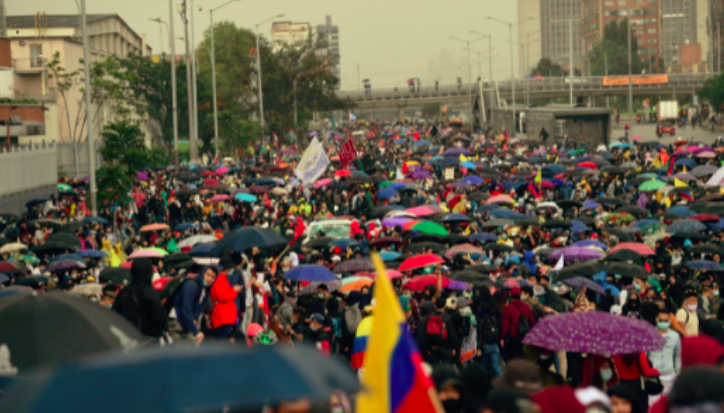RIO DE JANEIRO, BRAZIL – The main trade unions in Colombia called this Thursday (26) for a large demonstration that evoked the massive protests experienced from March to May of this year, but which has not had as much support of popular sectors and youth as the previous ones.
The largest concentration was in Bogotá, where several hundreds of people made the now traditional march from the National Park to the central Plaza Bolivar, where the Congress and the Mayor’s Office are located.
Read also: Check out our coverage on Colombia
The unions intend with the mobilization to speed up the proceedings in Congress. The bills they filed at the beginning of the legislature, with social demands at the end of July, can be debated.

They also seek to express again the rejection of the tax reform presented by the government, a less controversial one, which they claim does not adversely affect the middle and lower classes, after the massive demonstrations of the last months overthrew the previous one and forced the resignation of the Minister of Finance, Alberto Carrasquilla.
“This reform intends to freeze salaries for 10 years for public workers and give the government powers to liquidate entities, which may result in a labor massacre”, explained the Central Unitary Workers’ Union (CUT) of Colombia, Francisco Maltés.
In addition, as the union leader explained, they also want the government to comply with the Inter-American Commission on Human Rights (IACHR) recommendations following the visit. It calls for greater efforts to monitor police actions and a greater guarantee of respect for peaceful protest.
AN ATOMIZED MARCH
The mobilizations, which also took place with low attendance in other cities such as Cali, Medellin, or Barranquilla, did not have the support of some circles of the so-called front line (the young people who, with their faces covered and wearing handmade shields and helmets, interpose their bodies to the police force in the protests).
The young people consider that the unions do not represent them and criticize the fact that there was no dialogue nor did they take into account their demands, which revolve around the action of the police both in the demonstrations and in the popular neighborhoods, decent living conditions, job opportunities, etc.
However, in Popayán, the call coincided with marches in repudiation of the murder of student leader Esteban Mosquera a few days ago in this city, a young man very active against the violence of the public forces and who had lost an eye due to police action in the protests.
In the capital, more than a hundred marched in very atomized groups, peacefully and under chants of “the people do not give up, dammit”, and the music of rock bands with vindictive lyrics.
“The Strike Committee is going to be evaluating the political circumstances and later will decide if there will be more actions of social mobilization,” Maltés advanced.
The director of the Colombian Police, Jorge Vargas, assured this morning that there were “minimal concentrations in the country” and that the “public and peaceful demonstration” was being “guaranteed”.
The past protests, which began on April 28 and lasted for weeks, decreasing in intensity as time went by, had episodes, especially in the city of Cali, of serious human rights violations, with excessive actions by the police, blockades by demonstrators and civilians firing firearms at the protesters.
The Prosecutor General’s Office documented more than twenty deaths in the 50 days of protests, but several human rights organizations raise that figure to 84, at least 20 by police gunfire.

